The pursuit of financial profit without measuring social and environmental or cultural consequences has led to the denigration of our environment and social structure (values, attitude belief and behaviors and important community aspirations). This is evident in the ever increasing regional government legislation designed to force compliance of community and customer expectation. Te Whangai collaborative approach utilises the economy that bought all the advantages to Aotearoa communities to cooperatively restore communities and environment.
A quadruple bottom line reporting structure is designed to enhance business ability to measure sustainable business opportunities, advantages and credibility.
The objective of adding reported triple bottom line profit outcomes to the existing financial reported profits in a manner that further enhances business ability gain an even more sustainable export opportunity. Achieving this ahead of other world markets would benefit the whole of the NZ economy and opportunities for future generations.
To expect business alone to be responsible for achieving this will create further production costs threatening profitability, viability and competitive edge. Te Whangai Business model collaborates with available sector resources creating win-win partnerships to achieve community lead expectations with community resources in partnership with local business. The outcome, a quadruple bottom line profit report supported by community that reinforces the values placed on the sustainable production of products produced out of Aotearoa.
SEEC™ a non-financial measurement tool, (under development) reports Social, Environmental and Cultural outcomes that have had investment or contracted outcomes that can be measured in both financial and community investment profit outcome terms. This has the ability to clearly identify the partnership contribution throughout community.
By organising all of community existing resources, costs involved, by achieving all of the win-win desired outcomes, are shared throughout the community in line with the expected benefits. The greater the desire to walk together as a community the greater the outcomes driving a thriving community fit for future generations.
The Vision
Te Whangai Trust aims to develop a measure of the four pillars that sustainability is dependent upon. SEEC™ – Social, Environmental, Economic and Cultural profit measurements.
Te Whangai’s collaborative business partnerships which seek to provide business with individualised, specific, positive outcomes as a result of their investment in community and social and environmental good. This symbiotic relationship is specific to the needs of each partnership combination and the community it operates in. The philosophy becomes the driver behind the partnership , and a partnership evolved to meet the needs of all partners in a win/ win scenario, rather than a systemic one size fits all approach.
Government partnerships are designed to add value to the financial contribution that Government is able to make. The parameters around contracted outcomes are limited and time specific and fail to meet the needs of high risk families failing through the chasm that is developing through current fiscal and economic policy.
Te Whangai proposes empowering the community to work in partnership with Government, corporate and Philanthropic organisations to create the most productive current and future needs of the economy and our greatest resource- our people.
Environmentally focused platforms create the opportunity for generate multiple outcomes from social investments. Business partnerships create a conduit from life and work skills training to internships allowing business to and prospective employees to engage in a non contractual manner prior to employment opportunities . This creates a collaborative partnership between Te Whangai and various business disciplines wishing to mitigate risk and creating win/win environments.

People working in the field at Te Whangai Trust.
What is a triple bottom line and how does buying Te Whangai plants relate to it?
he Triple Bottom Line (TBL) is a method that allows companies to assess their performance against three bottom lines: environmental, social and economic.
When a business or organisation with a triple bottom line approach purchases Te Whangai native plants and services, the two bottom lines of Social and Environment are boosted. For details, see the discussion on 300% return here.
What does Te Whangai do to gain support in the local community?
Local business skills and services are used as much as possible. This allows community members to experience firsthand what can be achieved. Volunteers from the local community are encouraged to come and work alongside our team members. Volunteers then can answer questions about Te Whangai in the local community, based on their personal experience. This dispels fear of the unknown. Our local marae is involved. Representatives of local government and civic organisations are invited to come for visits, to see firsthand how Te Whangai works.
